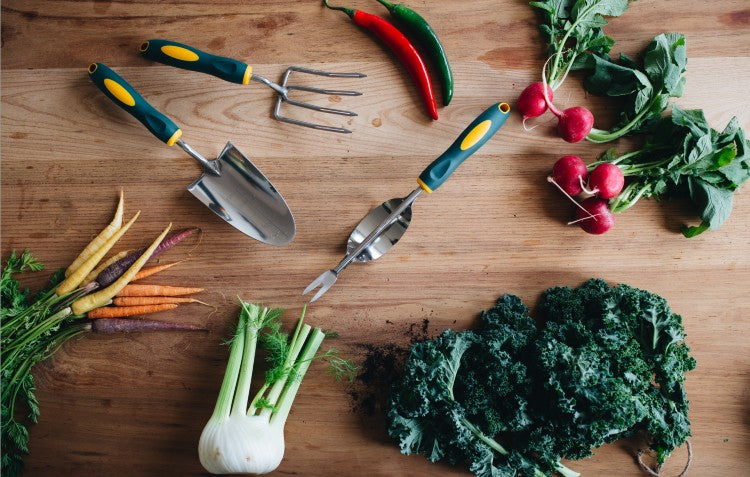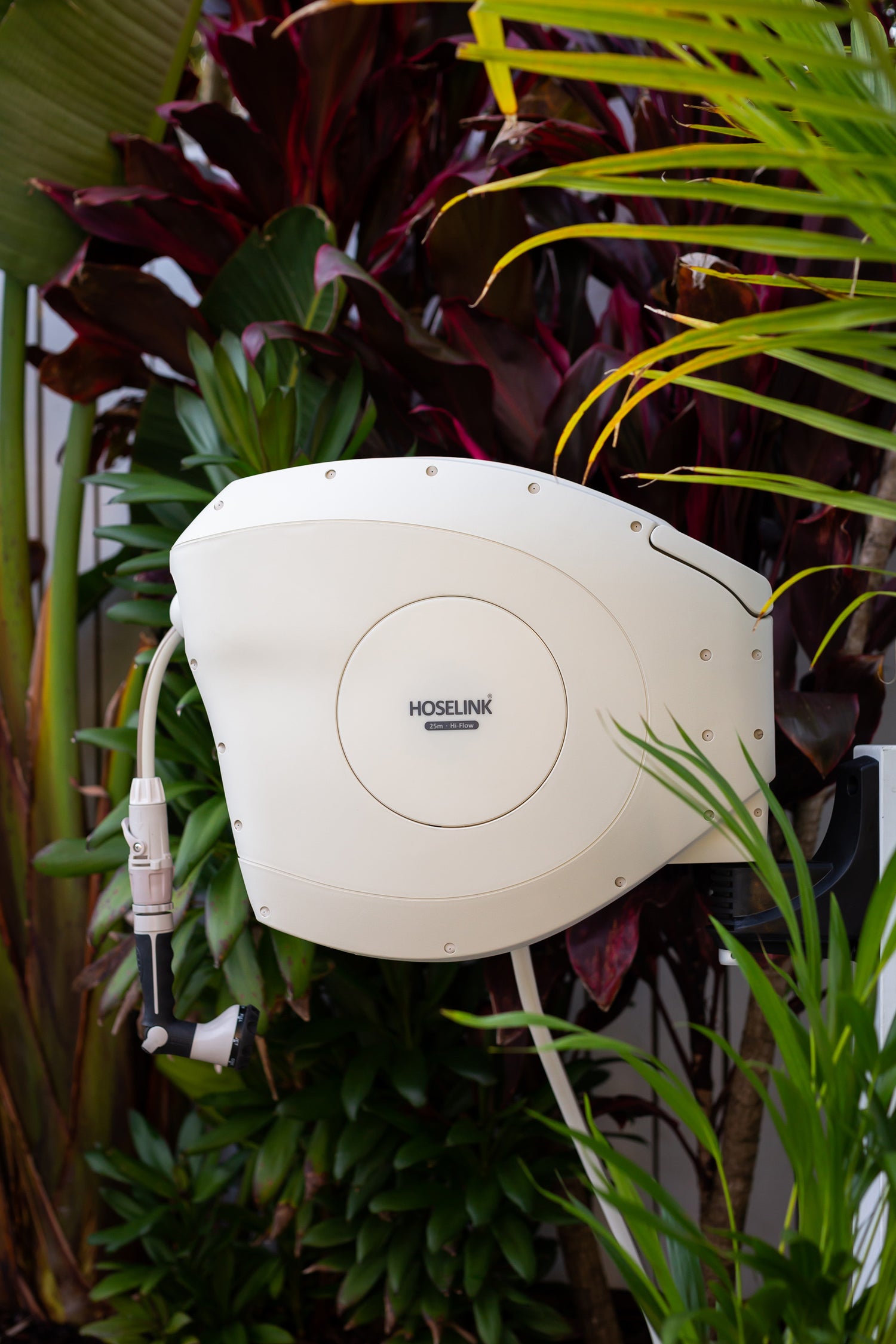An edible garden is a perfect solution to your garden desires. It will leave you spoilt for choice when it comes to using products in your kitchen and when in full swing, your garden will be covered in shades of vibrant red with juicy tomatoes and the grassy green hues of fragrant herbs.
Preparing your garden for planting can be made easy with Hoselink's Trowel, Fork and Weeder Set. Each tool will aid in digging, potting, planting and cultivating your new seedlings. We advise keeping your soil moist and hydrated during the planting stage of your veggie patch. To help, use Hoselink’s Shower Wand, specifically designed to deliver a soft spray that is gentle on new seedlings. The sprayer also comes in an extra-long length to reach those hard-to-access areas of your garden.
To have a fruitful edible garden in time for summer, spring is the best time to plant the following:
- Red bok choy - Planting this kitchen staple in early spring will have your garden filled with low-growing, deep purple blades come summer. The stalks are semi-translucent with brilliant pale green veins running through the oval-shaped blades. Not only will this plant make an eye-catching addition to your garden, but in the kitchen, red bok choy can be used in all your favourite Thai dishes and soups, delicious sautèed, steamed or even eaten raw.
- Magenta Spreen - Not a common vegetable, best planted in early spring, this plant is bound to give your garden height with its average length ranging from 50cm to 2m. When growing, this plant starts an auburn-tinged colour with a pink centre. As the plant grows, expect frosted green leaves with a red underside. Ensure you cook this vegetable before consumption. Rich in vitamins C and E, the magenta screen is the perfect substitute for spinach.
- Eggplant - The vast colour and shape variations of this veg makes it a delight to display both in the garden and on your plate. Everything about this resembles summer climate toughness, from the leathery ridge and waxy deep purple skin to the sharp prickles on its thick, broad leaves. The fruits of this low-growing vine plant are especially tasty sliced and grilled on the barbie or roasted in the oven, complementing most recipes.
- Capsicum - Why not add all three to your garden when such a versatile plant comes in a tricolour variety? Boasting red, yellow and green fruits, the capsicum is best planted when the soil remains at a consistent temperature of 20 degrees. As the fruits begin to flower, this is the time when capsicums need the most attention. Ensure your plants are saturated with plenty of water. Looking after your capsicums now will ensure that, when the cooler months arrive after the fruits are long gone, your capsicum plant will return stronger, healthier and won’t need nearly as much attention for its second round of fruiting. Eat capsicums raw, roasted, stir-fried or grilled. Versatile capsicums add colour and crunch to any dish.
- Squash - Want to add some golden veggies to your garden? Then planting squash is a must! It’s best to plant these around two months before expecting fruit. High in vitamins A and C and niacin, the tender flesh of the squash can be deliciously roasted, served fresh in a salad, steamed or braised. Squash will accompany almost any dish in your kitchen. The plant that keeps on giving, squash blossoms will flower on a healthy plant and are edible, making them the perfect garnish for any dish. A sweet delicacy when battered, fried or stuffed with your favourite herbs and spices. It is best to harvest squash blossoms when they have closed buds so they are firm, making them easier to cook with.

- Tomatoes - Easily a favourite when it comes to summer produce, tomatoes can be planted as early as September. If you decide to sow these fabulous fruits before the warmer nights, ensure you pick the appropriate location in your garden for the tomatoes to grow in. Whether you plant in a pot or directly into the soil, you will need to cover the seedlings or bring the planters indoors to prevent the cold from stunting their growth. Alternatively, hold off planting until late October and expect fruit around early January. Tomatoes are very versatile in their growing space. If you’re looking to take things up a notch - literally! Then why not plant closer to the garden fence or install climber stakes for your plant to grow upon? The five-petalled yellow flowers begin to bloom before the plant bears fruit. The plump scarlet and yellow varieties come in a multitude of shapes too. Tomatoes can be very abstract in shape, from spherical ovals to elongated eggplant-like shapes.
- Cucumber - A salad favourite for when the weather warms up, cucumber is best grown in October. Cucumbers grow quickly and will be on your plate by Christmas. To achieve a lush green crop, seeds will need to be watered regularly and fed with liquid fertiliser or topped up with compost. Using mulch around the plants will deter weeds from invading and allow you to keep your cucumbers moist. As your cucumber plant grows, small yellow flowers will begin to appear along the floor-creeping vine. Typically, cucumbers will grow in a deep green cylindrical shape with a hard outer rind and soft, juicy flesh. You may also notice small yellow-green tendrils emerging from the vine. These tendrils are to facilitate the vine in climbing. If you want to add a vertical feature to your garden, then why not add climbing stakes for the plants to grow upon?

Tips
The initial propagation occurs when we buy our veggies from seedlings. The reward of seeing tiny plants shooting out of the ground for the first time is lost in the establishment stages that have already been completed when we buy the seedlings. If you are wary of growing veggies from seed, get started by planting your seeds in containers (ice-cream tub size is ideal). Layer your container with moist manure and soil and ensure you aerate it before planting your seeds. Keep the container close to direct sunlight by a window, taking special care to monitor soil moisture levels. You do not want your soil to be dry. As the seedlings begin to grow, start moving the container outside during the day and bring it inside during the night so as not to overexpose the seedlings to dramatic temperature changes. Keep an eye on the height of your seedlings: once they reach the 4-5cm mark and begin to produce leaves it is time to move the plant to a larger pot outside or directly into the soil with the rest of your veggies. A strong plant will produce a fuller crop, so taking these primary precautions will ensure you are supporting your seedlings as much as possible during the early stages.
Now that spring has arrived, it is the perfect time for composting. Compost is essential for the foundations of any veggie patch. Compost can easily be homemade. Compost is is the breakdown of organic matter which generally consists of banana peels, coffee grounds, citrus rinds, potato skins, apple cores and other organic food and plant matter. Compost will provide your seedlings with the nutrients they need in every stage of growth. If kept moist and regularly topped up, the compost will provide a slow release of vitamins and minerals throughout the season without the need for any harsh chemicals.










